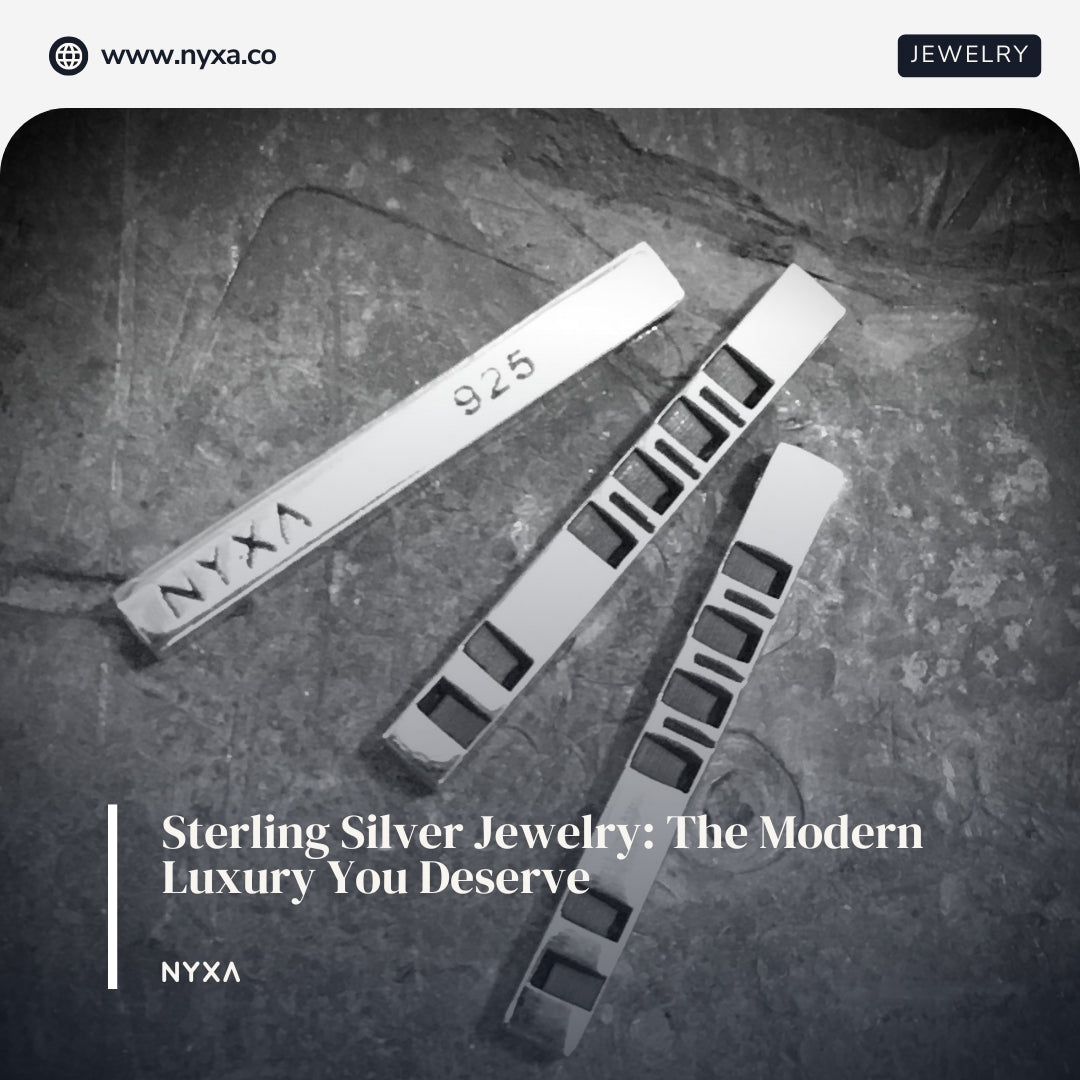
Sterling Silver Jewelry: The Modern Luxury You Deserve
Share
Since the 12th century, sterling silver jewelry has captivated the world with its timeless allure. Today, it stands as one of the most coveted choices in fine jewelry, seamlessly blending history with modernity. But what sets sterling silver apart from other types of silver, and why is it the preferred choice for jewelry? Dive into the captivating world of sterling silver jewelry with NYXA and discover its enduring charm.

The Essence of Sterling Silver Jewelry
Sterling silver, a precious metal composed of 92.5% pure silver and 7.5% metal alloy (typically copper), is also known as 925 silver. This combination not only enhances its strength but also preserves the innate beauty of silver. Silver, symbolized by Ag on the periodic table, is a rare and valuable element, making sterling silver jewelry a luxurious choice.
Exploring Types of Silver in Jewelry
There are three primary types of silver used in jewelry:
- Fine Silver Jewelry: 99.9% silver.
- Sterling Silver Jewelry: 92.5% pure silver and 7.5% alloy.
- Silver-plated Jewelry: A base metal coated with a thin layer of silver.
Authenticity of Sterling Silver Jewelry
Sterling silver is indeed real silver, crafted to be more durable by blending pure silver with a metal alloy. When investing in sterling silver jewelry, it's crucial to ensure its authenticity. Unlike silver-plated items, genuine sterling silver is more durable and valuable. Look for markings such as .925, Sterling, or Ster to confirm authenticity. If unmarked, a magnet test can help; sterling silver is non-magnetic, whereas silver-plated items will be more likely to adhere to a magnet.
Sterling Silver Jewelry vs. Fine Silver Jewelry
While fine silver boasts a 99.9% purity, its softness makes it impractical for everyday use. Historically, fine silver was used for coins, dishware, and decor. Today, its antibacterial properties make it essential in various industries, from medical equipment to electronics. However, for jewelry, sterling silver jewelry reigns supreme. Its added alloy increases durability, making it perfect for everyday wear without sacrificing elegance. Nonetheless, pure silver has its place in the jewelry where its malleability is beneficial, such as for bezel settings used to hold stones where the ability to form the bezel around the stone is key.
Economic Dynamics: Silver Jewelry vs. Sterling Silver Jewelry
Fine silver, being more rare and valuable, is typically more expensive than sterling silver. The price difference is influenced by the form of silver and the fluctuating silver spot price, determined by global economic factors. Fine silver coins and bars hold higher investment value, while sterling silver jewelry varies in price based on design, size, and condition.

Jewelry Craftsmanship: Fine Silver vs. Sterling Silver
Fine silver, while beautiful, is too malleable for jewelry, leading to scratches and warping. Sterling silver, with its enhanced durability, offers a sleek and sturdy alternative, perfect for crafting exquisite pieces that stand the test of time.
A Glimpse into the History of Sterling Silver Jewelry
Sterling silver's journey began in the 12th century, initially linked to British currency. By the 13th century, its use expanded to tableware and jewelry. The 1800s saw sterling silver tableware and jewelry gaining popularity in America, solidifying its status as a premier choice for fine jewelry. Learn more about the history and properties of sterling silver on the Silver Institute's website.
The Allure of Sterling Silver Jewelry in Modern Times
Today, sterling silver jewelry is celebrated for its sleek appearance, durability, and affordability. Its high strength-to-weight ratio ensures lightweight wearability with robust resilience. Unlike pure silver, sterling silver offers an attainable luxury, making it a preferred choice for modern jewelry enthusiasts.
Sterling Silver Jewelry vs. White Gold Jewelry
Sterling silver and white gold, while similar in appearance, differ significantly. White gold, an alloy of gold and another metal, is more durable but also more expensive. Sterling silver, though slightly softer, offers a more affordable luxury without compromising on elegance. Both metals require proper care to maintain their pristine condition.
Caring for Sterling Silver Jewelry
Sterling silver jewelry requires regular cleaning and proper storage to prevent tarnishing. Keep your pieces in an airtight container away from moisture and direct light. With proper care, sterling silver jewelry can last a lifetime and beyond, embodying a legacy of refined elegance.
The NYXA Experience
At NYXA, our sterling silver jewelry is crafted to perfection, blending historical influences with modern design for pieces that are both timeless and avant-garde. Explore our curated selection of sterling silver necklaces, bracelets, earrings, and rings, each designed to elevate your style with understated sexy sophistication.
Frequently Asked Questions About Sterling Silver Jewelry
Is Sterling Silver Jewelry Good Quality? Yes, sterling silver jewelry is a high-quality, premium material known for its durability and elegance.
Is Sterling Silver Jewelry Hypoallergenic? Sterling silver is generally hypoallergenic, making it ideal for most people with sensitive skin.
Does Sterling Silver Jewelry Rust? Sterling silver does not rust over time.
How Do I Prevent Sterling Silver Jewelry From Tarnishing? Regular cleaning and proper storage in an airtight container can prevent tarnishing.
Stainless Steel vs. Sterling Silver Jewelry Stainless steel is more durable and affordable but lacks the preciousness and elegance of sterling silver jewelry, which is ideal for fine, valuable jewelry.
Shop NYXA Sterling Silver Jewelry
Discover the allure of sterling silver with NYXA. Our meticulously crafted designs are more than jewelry; they are future artifacts, blending the past with the present to create timeless pieces that resonate with refined simplicity and attainable luxury. Explore our collection and redefine elegance with NYXA.
